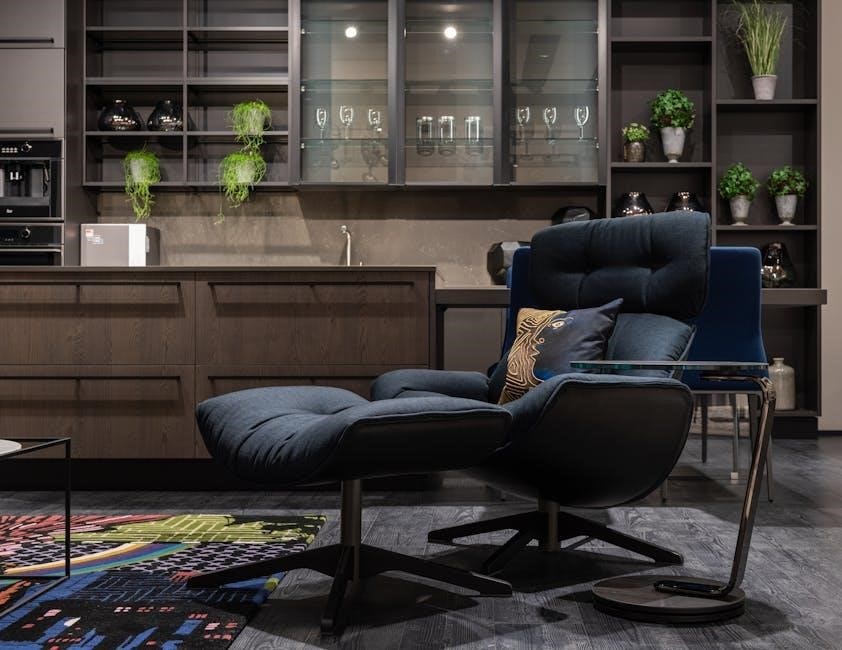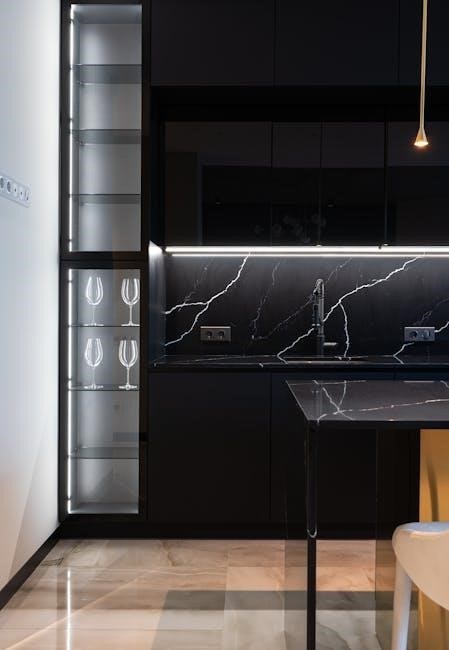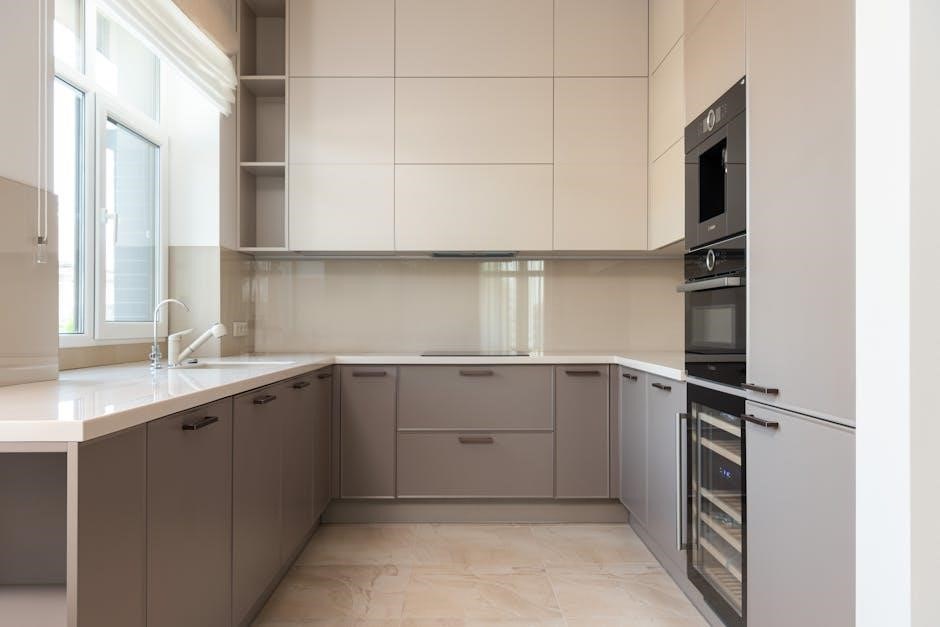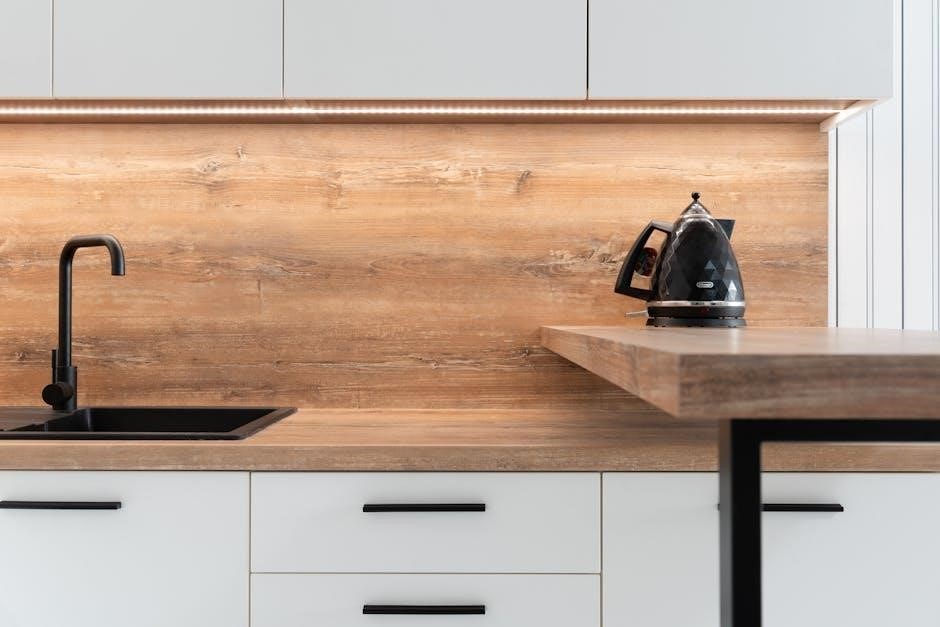kitchen cabinet dimensions pdf

Kitchen cabinet dimensions are crucial for efficient design and functionality․ This guide provides standard measurements for base, wall, and tall cabinets, ensuring optimal space planning and aesthetics․
Standard Dimensions for Kitchen Cabinets
Standard kitchen cabinet dimensions vary by type․ Base cabinets are typically 34․5-36 inches high, 24-26 inches deep, with widths ranging from 12 to 48 inches․ Wall cabinets are usually 30-42 inches high and 12-24 inches deep, while tall cabinets range from 80-84 inches in height and 24 inches in depth․
2․1 Base Cabinets
Base cabinets are foundational elements in kitchen design, typically measuring 34․5 to 36 inches in height, 24 to 26 inches in depth, and available in widths from 12 to 48 inches․ They provide essential storage for cookware and utensils while supporting countertops․ Standard configurations include single and double doors, with some models offering drawers for enhanced functionality․ These dimensions ensure compatibility with most countertops and appliances, making them versatile for various kitchen layouts and design preferences․
2․2 Wall Cabinets
Wall cabinets are mounted above countertops, typically measuring 12 inches in depth and varying in height from 30 to 42 inches․ Widths range from 9 to 48 inches, offering flexibility for different kitchen layouts․ These cabinets are ideal for storing dishes, glasses, and lighter items․ Their height and depth ensure they fit seamlessly above countertops or sinks, while their design complements base cabinets․ Frameless European styles are popular, featuring full overlay doors for a sleek appearance․ Proper installation requires wall fixings to support their weight and ensure stability․
2․3 Tall Cabinets
Tall cabinets, often used as pantries or larders, stand between 60 to 84 inches in height, offering ample storage for dry goods or appliances․ Depths typically range from 24 to 30 inches, with widths varying from 12 to 48 inches․ These cabinets maximize vertical space, making them ideal for larger kitchens․ They often feature adjustable shelves to accommodate items of varying sizes․ Their tall design allows for efficient use of corner spaces or as standalone units, enhancing kitchen organization and functionality while maintaining a cohesive design with other cabinetry․

Materials and Construction of Kitchen Cabinets
Kitchen cabinets are built from materials like engineered wood, MDF, and plywood․ Construction methods include dowel joints, staples, and screws for durability and structural integrity․
3․1 Types of Materials Used
Kitchen cabinets are crafted using various materials, including medium-density fiberboard (MDF), plywood, and engineered wood․ These materials offer durability and resistance to wear․ MDF is smooth and ideal for painting, while plywood provides excellent structural strength․ Engineered wood combines style and stability․ Additionally, laminated chipboard is often used for carcasses, ensuring cost-effectiveness without compromising quality․ These materials are chosen for their ability to withstand the humid kitchen environment and support the weight of countertops and appliances effectively․
3․2 Construction Methods
Kitchen cabinets are constructed using engineered dowels, glue, screws, or staples for durability․ Panels and rails are joined securely, ensuring stability․ Frameless European designs offer full access and modern aesthetics․ This method eliminates traditional frames, providing a sleek look and maximize interior space․ Construction techniques focus on strength and functionality, catering to various kitchen needs while maintaining a contemporary appeal․

Design Considerations for Kitchen Cabinets
Designing kitchen cabinets involves balancing layout, functionality, and style․ Consider door styles, finishes, and drawer configurations to create a cohesive and practical space that reflects your lifestyle․
4․1 Layout and Functionality
Optimizing your kitchen’s layout and functionality begins with understanding cabinet dimensions․ Base cabinets are typically 34․5-36 inches high, 24-26 inches deep, and come in widths like 12, 18, 24, 30, 33, 36, and 48 inches․ These measurements ensure they fit under countertops and provide ample storage․ Wall cabinets, usually 30-42 inches in height, are mounted above countertops to maximize vertical space․ Tall cabinets, standing at 84-96 inches, are ideal for pantry storage or housing appliances like ovens․ Proper spacing between cabinets ensures smooth workflow and accessibility, making your kitchen both functional and efficient․
4․2 Door Styles and Finishes
Door styles and finishes significantly impact the aesthetic and functionality of kitchen cabinets․ Popular styles include full-height doors, which add a modern touch, and traditional Shaker designs for a timeless look․ Finishes range from painted options like Sherwin Williams’ neutral tones to laminate and wood veneers․ Materials such as laminated chipboard ensure durability, while engineered dowels and glue enhance construction quality․ Choosing the right style and finish ensures your cabinets align with your kitchen’s design, creating a cohesive and visually appealing space․
4․3 Drawer Configurations
Drawer configurations offer versatility in kitchen design, catering to various storage needs․ Standard setups include top drawers at 8 inches high and bottom drawers at 10․5 inches, constructed from 5/8-inch thick finger-jointed hardwood․ These configurations can be mixed to optimize space, with options for single or multiple drawers․ Advanced systems like ArciTech ensure smooth functionality․ Drawer dimensions align with overall cabinet measurements, providing a seamless integration into your kitchen layout while enhancing both practicality and visual appeal․

Installation Requirements for Kitchen Cabinets
Kitchen cabinet installation requires precise wall fixings and brackets for stability․ Use 25mm screws for 12mm decor ends and ensure 30mm spacing for tower units․ Proper fitting ensures durability․
5․1 Wall Fixings and Brackets
Wall fixings and brackets are essential for secure cabinet installation․ Use 25mm screws for 12mm decor ends to ensure stability․ Deep wall cabinets often require standard wall fixing methods․ Proper bracket placement prevents sagging and ensures longevity․ Allow 30mm spacing on each side for tower units to accommodate profiles․ Verify all fixings are level and aligned before securing to avoid misalignment․ Proper installation guarantees safety and durability, especially for heavy cabinets․ Always follow manufacturer guidelines for optimal results․
5․2 Base Cabinet Fixing Brackets
Base cabinet fixing brackets ensure stability and alignment․ Cabinets typically feature laminated chipboard carcasses, 18mm thick, with heights of 777mm and depths of 530mm․ ArciTech drawer systems enhance durability․ Brackets prevent movement and ensure level installation․ Standard base cabinets, like the 9x30x12 model, require secure fixing to support countertops․ Proper bracket placement is crucial for load distribution․ Always consult manufacturer guidelines for specific models to ensure compatibility and safety․ This ensures your kitchen remains functional and visually appealing for years to come․
Common Kitchen Cabinet Models and Dimensions
Common kitchen cabinet models include base, wall, and tall units․ Base cabinets like the 9x30x12 model are standard, while wall cabinets often measure 30×12 inches deep․
6․1 Base Cabinet Models
Base cabinets are foundational elements in kitchen design, offering storage and countertop support․ Common models include single-door units like the B-09, measuring 9x30x12 inches, and larger configurations such as 18×34․5×24 inches․ These dimensions accommodate various layouts, ensuring functionality․ Depths typically range from 24 to 26 inches, with widths in multiples of 3 inches, from 12 to 48 inches․ They often feature full-height doors or drawers, enhancing accessibility and modern aesthetics․ Proper spacing and construction materials ensure durability and alignment with kitchen styles․
6․2 Wall Cabinet Models
Wall cabinets offer versatile storage solutions, typically measuring 30 to 42 inches in height and 12 to 48 inches in width․ Depths are usually 12 inches, ensuring they fit seamlessly above countertops․ Models like the W-9-30 feature single doors, while others include multiple doors for larger spaces․ Some designs incorporate glass fronts or open shelving for decorative appeal․ Heights vary to accommodate specific needs, such as 39-inch models for standard kitchens or taller units for maximizing vertical space, all while maintaining consistent styling and functionality․

How to Choose the Right Cabinets for Your Kitchen
Assess your kitchen space, consider lifestyle needs, and select styles that blend functionality with aesthetics, ensuring optimal use of available dimensions for a seamless design․
7․1 Assessing Your Kitchen Space
Accurately measure your kitchen to determine the best cabinet sizes․ Consider the layout, door swing directions, and clearance for appliances․ Note the height of ceilings and placement of electrical outlets․ Standard base cabinets are 34․5–36 inches high, while wall cabinets typically range from 30–42 inches in height․ Ensure there’s enough space for countertops and fixtures․ Use a floor plan to visualize how cabinets will fit, maximizing storage without compromising functionality․ Proper measurement ensures a tailored fit for your kitchen needs․
7․2 Considering Lifestyle and Needs
Your lifestyle dictates cabinet choices․ Busy professionals may prefer easy-access layouts, while large families need ample storage․ Tall cabinets are ideal for maximizing vertical space, offering extensive storage for dry goods․ Consider drawer configurations for utensils and pots․ Door styles like full-height doors can enhance modern aesthetics․ Assess daily needs, such as wine racks or spice pullouts․ Ensure cabinets align with your cooking habits and entertaining style, creating a functional yet stylish kitchen tailored to your preferences and routines․ This ensures long-term satisfaction and practicality․
7․3 Selecting Styles and Finishes
Choosing the right style and finish for your cabinets enhances your kitchen’s aesthetic․ Popular door styles include slab, Shaker, and raised panel designs․ Finishes range from painted, stained, or laminated options․ Consider hardware like knobs or handles to complement the design․ The style should reflect your kitchen’s overall theme, whether modern, traditional, or farmhouse․ Ensure the finish aligns with your countertop and flooring for a cohesive look․ Custom finishes can add uniqueness, while standard options offer affordability and timeless appeal․ This decision significantly impacts the visual appeal and functionality of your kitchen space․

Measuring Your Kitchen for Cabinet Installation
Accurate measurements are essential for a seamless cabinet installation․ Measure walls, floors, and existing fixtures to ensure cabinets fit perfectly․ Use a tape measure and record all dimensions carefully for precise planning and ordering․ Consider the space for doors and drawers to open fully without obstruction․ Proper alignment with countertops and appliances is also critical․ This step ensures your kitchen layout is functional and visually appealing, avoiding costly adjustments later․ Plan meticulously for a stress-free installation process․
8․1 Tools and Techniques
Measuring your kitchen requires precise tools and methods․ Use a tape measure, spirit level, and pencil to record accurate dimensions․ Mark wall studs and note electrical outlets․ Measure from floor to ceiling for tall cabinets and across walls for base units․ Ensure doors and drawers have clearance by adding 2-3 inches to openings․ Use graph paper to sketch your layout, noting appliance locations and plumbing fixtures․ Double-check measurements to avoid errors․ Consider using laser levels for straight alignments and digital calipers for exact widths․ Proper planning ensures a flawless installation and optimal space utilization in your kitchen design․ Accuracy is key to achieving the desired functionality and aesthetic appeal․
8․2 Accounting for Countertops and Fixtures
When measuring for cabinets, account for countertops and fixtures to ensure proper fit and functionality․ Measure from the floor to the top of the countertop (typically 36 inches) and note the depth of sinks, cooktops, and appliances․ Allow 1-2 inches for overhangs and spacing around fixtures․ Ensure handles and knobs have clearance by adding 2-3 inches to door and drawer openings․ Proper alignment with electrical outlets and plumbing fixtures is essential․ Measure around obstructions like windows or radiators to maintain even spacing․ Accurate measurements prevent misalignment and ensure smooth installation, creating a seamless kitchen design․
Frequently Asked Questions About Cabinet Dimensions
- What are standard kitchen cabinet dimensions?
- How to measure spaces for new cabinets?
- What materials are commonly used?
- How to choose the right style?
9․1 Common Queries on Sizes and Materials
Common questions about kitchen cabinet dimensions often revolve around standard sizes and materials․ Base cabinets typically range from 34․5 to 36 inches in height, while wall cabinets are usually 30 to 42 inches tall․ Tall cabinets can reach up to 84 inches․ Materials like MDF, plywood, and solid wood are popular for durability․ Finishes such as painted, stained, or laminated surfaces are also frequently queried for aesthetic preferences․
9․2 Installation and Maintenance FAQs
Installation and maintenance FAQs often focus on proper fitting and care․ Wall cabinets require sturdy brackets, while base cabinets need level floors for stability․ Regular cleaning with mild detergents prevents damage․ Soft cloths avoid scratching finishes․ Tightening screws periodically ensures longevity․ Avoid harsh chemicals to maintain material integrity․ Proper alignment during installation is key for functionality and aesthetics․ These practices ensure cabinets remain durable and visually appealing over time, addressing common concerns effectively․
Additional Resources for Planning Your Kitchen
Explore downloadable PDF guides, BIM objects, and manufacturer recommendations for detailed kitchen planning․ These resources offer comprehensive tools for designing your ideal kitchen space effectively․
10․1 Downloadable PDF Guides
Downloadable PDF guides provide comprehensive details on kitchen cabinet dimensions, materials, and design tips․ These resources include detailed diagrams, standard measurements, and practical advice for optimal kitchen planning․ They often cover base, wall, and tall cabinet dimensions, helping you visualize your space effectively․ Many guides also offer tips on selecting styles, finishes, and configurations to match your lifestyle and needs․ Utilize these PDFs to ensure precise measurements and a well-organized kitchen layout, making your design process smoother and more efficient․
10․2 BIM Objects and Design Tools
BIM objects and design tools offer advanced solutions for kitchen planning․ These resources provide detailed 3D models and specifications for cabinets, enabling precise design and visualization․ Tools like SketchUp, Autodesk, and Revit support custom layouts, while downloadable BIM objects from manufacturers ensure accuracy․ They help integrate cabinet dimensions seamlessly into your design, streamlining the planning process․ Use these tools to create realistic models, optimize space, and achieve professional-grade kitchen designs tailored to your specific needs and preferences․
10․3 Manufacturer Recommendations
Manufacturers often provide detailed guidelines for kitchen cabinet dimensions, ensuring compatibility and optimal performance․ They recommend specific materials, like laminated chipboard, and construction methods for durability․ Standard dimensions for base, wall, and tall cabinets are typically outlined, along with door styles and finishes․ Many manufacturers, such as Sandi Cabinet, emphasize CARB2 certification for safety and quality․ These recommendations also include drawer systems, such as ArciTech, and installation tips․ Follow these guidelines to ensure your cabinets fit seamlessly and meet your kitchen’s functional and aesthetic needs․ Always check manufacturer resources for precise specifications․